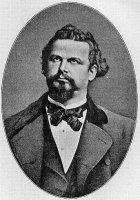Ludwig II of Bavaria
Ludwig II of Bavaria
Reading Comprehension for August 25
Have you ever seen Disneyland's Sleeping Beauty Castle? If you think the building itself is a wild imagining, then you are in for a big surprise! As it turns out, Disneyland's Sleeping Beauty Castle was not an original design. It was actually based on a real castle in southern Germany. That castle is called the Neuschwanstein Castle or the New Swan Castle. It was owned by King Ludwig II of Bavaria.
King Ludwig II, also known as the Swan King or Mad King Ludwig, was born on August 25, 1845, in Munich, Germany. His father was King Maximilian II of Bavaria. His mother was Princess Marie of Prussia. When Ludwig was just 18 years old, his father suddenly passed away. As the eldest son, he was the natural candidate for the throne. So this young prince became the new king in 1864. At the time, he had barely finished his studies and had absolutely no experience in politics.
Growing up, Ludwig was a sensitive child. He loved reading poetry. He liked acting. And he enjoyed operas, especially Richard Wagner's. Shortly after he became king, he invited this famous German composer to his court. Before Ludwig came along, Wagner was in a very dire situation. He had been in exile for twelve years. And he was heavily in debt. When Ludwig summoned him to live in Munich, the king paid off the composer's debts and gave him a generous salary. The two struck up a friendship that lasted to their dying days. Later, as Wagner settled comfortably into his new life, he began an affair with the wife of a conductor. The scandal, plus his reckless spending, made him the enemy of many people. In December 1865, Ludwig was under immense pressure. Reluctantly, he asked Wagner to leave Munich. To help the composer out, Ludwig set him up at a villa near Lake Lucerne in Switzerland. He continued to support him financially. Wagner, in return, forged ahead with his music. Many of his masterpieces, such as Tristan and Isolde (1865), The Mastersingers of Nuremberg (1867), and The Ring of the Nibelung (1858-1874), were all either written or completed during his days under Ludwig's protection.




